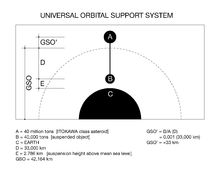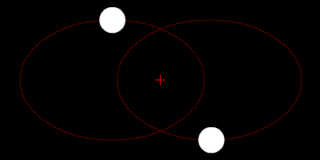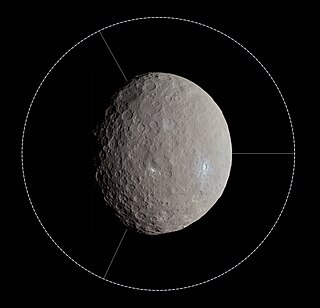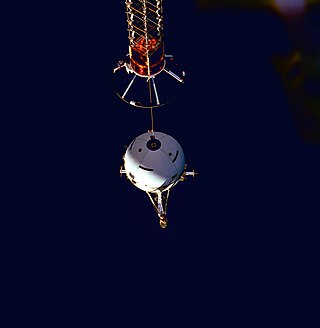A Universal Orbital Support System [1] is a concept for suspending an object from a tether orbiting in space.
Contents

A Universal Orbital Support System [1] is a concept for suspending an object from a tether orbiting in space.

A concept for providing space-based support to things suspended above an astronomical object. It is envisioned as a type of non-rotating tethered satellite system. The orbital system is a coupled mass system wherein the upper supporting mass (A) is placed in an orbit around a given celestial body such that it can support a suspended mass (B) at a specific height above the surface of the celestial body, but lower than (A). The relationship between (A) and (B) is such that it (A) moves higher as (B) is lowered towards the surface, the distance is related as an inverse proportion of their masses.
This system has been proposed for the Analemma Tower [2] concept, which employs the system to suspend a building from a cable supported by an asteroid orbiting Earth. [3]

Interplanetary spaceflight or interplanetary travel is the crewed or uncrewed travel between stars and planets, usually within a single planetary system. In practice, spaceflights of this type are confined to travel between the planets of the Solar System. Uncrewed space probes have flown to all the observed planets in the Solar System as well as to dwarf planets Pluto and Ceres, and several asteroids. Orbiters and landers return more information than fly-by missions. Crewed flights have landed on the Moon and have been planned, from time to time, for Mars, Venus and Mercury. While many scientists appreciate the knowledge value that uncrewed flights provide, the value of crewed missions is more controversial. Science fiction writers propose a number of benefits, including the mining of asteroids, access to solar power, and room for colonization in the event of an Earth catastrophe.

In celestial mechanics, the Lagrange points are points of equilibrium for small-mass objects under the gravitational influence of two massive orbiting bodies. Mathematically, this involves the solution of the restricted three-body problem.

Space exploration is the use of astronomy and space technology to explore outer space. While the exploration of space is currently carried out mainly by astronomers with telescopes, its physical exploration is conducted both by uncrewed robotic space probes and human spaceflight. Space exploration, like its classical form astronomy, is one of the main sources for space science.

A space elevator, also referred to as a space bridge, star ladder, and orbital lift, is a proposed type of planet-to-space transportation system, often depicted in science fiction. The main component would be a cable anchored to the surface and extending into space. An Earth-based space elevator cannot be constructed with a tall tower supported from below due to the immense weight—instead, it would consist of a cable with one end attached to the surface near the equator and the other end attached to a counterweight in space beyond geostationary orbit. The competing forces of gravity, which is stronger at the lower end, and the upward centrifugal force, which is stronger at the upper end, would result in the cable being held up, under tension, and stationary over a single position on Earth. With the tether deployed, climbers (crawlers) could repeatedly climb up and down the tether by mechanical means, releasing their cargo to and from orbit. The design would permit vehicles to travel directly between a planetary surface, such as the Earth's, and orbit, without the use of large rockets.
A synchronous orbit is an orbit in which an orbiting body has a period equal to the average rotational period of the body being orbited, and in the same direction of rotation as that body.

In astronomy, an analemma is a diagram showing the position of the Sun in the sky as seen from a fixed location on Earth at the same mean solar time, as that position varies over the course of a year. The diagram will resemble a figure eight. Globes of Earth often display an analemma as a two-dimensional figure of equation of time vs. declination of the Sun.

The orbital period is the amount of time a given astronomical object takes to complete one orbit around another object. In astronomy, it usually applies to planets or asteroids orbiting the Sun, moons orbiting planets, exoplanets orbiting other stars, or binary stars. It may also refer to the time it takes a satellite orbiting a planet or moon to complete one orbit.

In astronomy, the barycenter is the center of mass of two or more bodies that orbit one another and is the point about which the bodies orbit. A barycenter is a dynamical point, not a physical object. It is an important concept in fields such as astronomy and astrophysics. The distance from a body's center of mass to the barycenter can be calculated as a two-body problem.
A geocentric orbit, Earth-centered orbit, or Earth orbit involves any object orbiting Earth, such as the Moon or artificial satellites. In 1997, NASA estimated there were approximately 2,465 artificial satellite payloads orbiting Earth and 6,216 pieces of space debris as tracked by the Goddard Space Flight Center. More than 16,291 objects previously launched have undergone orbital decay and entered Earth's atmosphere.

A skyhook is a proposed momentum exchange tether that aims to reduce the cost of placing payloads into low Earth orbit. A heavy orbiting station is connected to a cable which extends down towards the upper atmosphere. Payloads, which are much lighter than the station, are hooked to the end of the cable as it passes, and are then flung into orbit by rotation of the cable around the center of mass. The station can then be reboosted to its original altitude by electromagnetic propulsion, rocket propulsion, or by deorbiting another object with the same kinetic energy as transferred to the payload.

The Hill sphere of an astronomical body is the region in which it dominates the attraction of satellites. It is sometimes termed the Roche sphere. It was defined by the American astronomer George William Hill, based on the work of the French astronomer Édouard Roche.

A lunar space elevator or lunar spacelift is a proposed transportation system for moving a mechanical climbing vehicle up and down a ribbon-shaped tethered cable that is set between the surface of the Moon "at the bottom" and a docking port suspended tens of thousands of kilometers above in space at the top.
An areostationary orbit or areosynchronous equatorial orbit (AEO) is a circular areosynchronous orbit (ASO) in the Martian equatorial plane about 17,032 km (10,583 mi) above the surface, any point on which revolves about Mars in the same direction and with the same period as the Martian surface. Areostationary orbit is a concept similar to Earth's geostationary orbit (GEO). The prefix areo- derives from Ares, the ancient Greek god of war and counterpart to the Roman god Mars, with whom the planet was identified. The modern Greek word for Mars is Άρης (Áris).
A momentum exchange tether is a kind of space tether that could theoretically be used as a launch system, or to change spacecraft orbits. Momentum exchange tethers create a controlled force on the end-masses of the system due to the pseudo-force known as centrifugal force. While the tether system rotates, the objects on either end of the tether will experience continuous acceleration; the magnitude of the acceleration depends on the length of the tether and the rotation rate. Momentum exchange occurs when an end body is released during the rotation. The transfer of momentum to the released object will cause the rotating tether to lose energy, and thus lose velocity and altitude. However, using electrodynamic tether thrusting, or ion propulsion the system can then re-boost itself with little or no expenditure of consumable reaction mass.

An orbital ring is a concept of an artificial ring placed around a body and set rotating at such a rate that the apparent centrifugal force is large enough to counteract the force of gravity. For the Earth, the required speed is on the order of 10 km/sec, compared to a typical low Earth orbit velocity of 8 km/sec. The structure is intended to be used as a space station or as a planetary vehicle for very high-speed transportation or space launch.

Electrodynamic tethers (EDTs) are long conducting wires, such as one deployed from a tether satellite, which can operate on electromagnetic principles as generators, by converting their kinetic energy to electrical energy, or as motors, converting electrical energy to kinetic energy. Electric potential is generated across a conductive tether by its motion through a planet's magnetic field.

The International Astronomical Union (IAU) defined in August 2006 that, in the Solar System, a planet is a celestial body that:

Non-rocket spacelaunch refers to theoretical concepts for launch into space where much of the speed and altitude needed to achieve orbit is provided by a propulsion technique that is not subject to the limits of the rocket equation. Although all space launches to date have been rockets, a number of alternatives to rockets have been proposed. In some systems, such as a combination launch system, skyhook, rocket sled launch, rockoon, or air launch, a portion of the total delta-v may be provided, either directly or indirectly, by using rocket propulsion.

Space tethers are long cables which can be used for propulsion, momentum exchange, stabilization and attitude control, or maintaining the relative positions of the components of a large dispersed satellite/spacecraft sensor system. Depending on the mission objectives and altitude, spaceflight using this form of spacecraft propulsion is theorized to be significantly less expensive than spaceflight using rocket engines.
This glossary of astronomy is a list of definitions of terms and concepts relevant to astronomy and cosmology, their sub-disciplines, and related fields. Astronomy is concerned with the study of celestial objects and phenomena that originate outside the atmosphere of Earth. The field of astronomy features an extensive vocabulary and a significant amount of jargon.